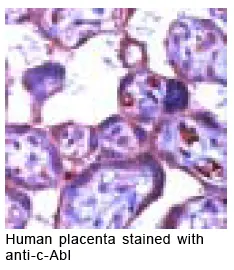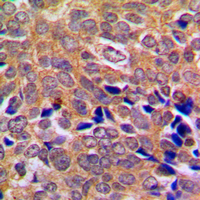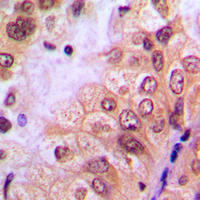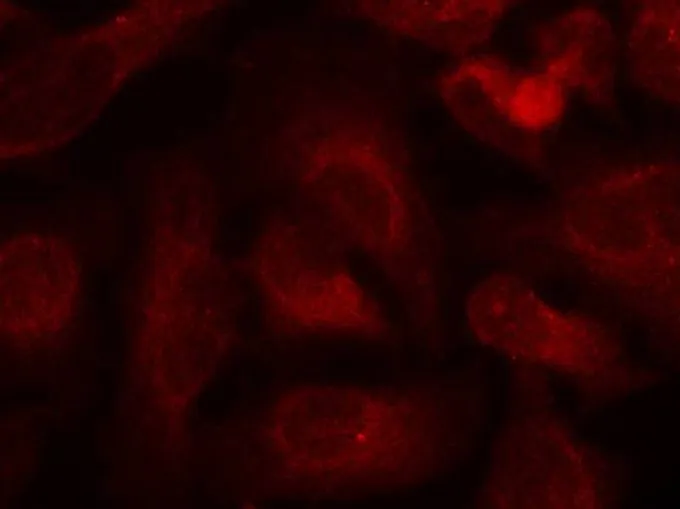![WB analysis of G361 whole cell lysate using GTX10528 c-Abl antibody [ABL-148]. Lane 1 : 1:4000 dilution Lane 2 : 11:2000 dilution Lane 3 : Negative control WB analysis of G361 whole cell lysate using GTX10528 c-Abl antibody [ABL-148]. Lane 1 : 1:4000 dilution Lane 2 : 11:2000 dilution Lane 3 : Negative control](https://www.genetex.com/upload/website/prouct_img/normal/GTX10528/GTX10528_WB_0804_1_22080401_622.webp)
WB analysis of G361 whole cell lysate using GTX10528 c-Abl antibody [ABL-148]. Lane 1 : 1:4000 dilution Lane 2 : 11:2000 dilution Lane 3 : Negative control
c-Abl antibody [ABL-148]
GTX10528
ApplicationsFlow Cytometry, ImmunoFluorescence, ImmunoPrecipitation, Western Blot, ImmunoCytoChemistry
Product group Antibodies
TargetABL1
Overview
- SupplierGeneTex
- Product Namec-Abl antibody [ABL-148]
- Delivery Days Customer9
- Application Supplier NoteWB: 1:2,000. *Optimal dilutions/concentrations should be determined by the researcher.Not tested in other applications.
- ApplicationsFlow Cytometry, ImmunoFluorescence, ImmunoPrecipitation, Western Blot, ImmunoCytoChemistry
- CertificationResearch Use Only
- ClonalityMonoclonal
- Clone IDABL-148
- ConjugateUnconjugated
- Gene ID25
- Target nameABL1
- Target descriptionABL proto-oncogene 1, non-receptor tyrosine kinase
- Target synonymsABL, BCR-ABL, CHDSKM, JTK7, bcr/abl, c-ABL, c-ABL1, p150, v-abl, tyrosine-protein kinase ABL1, ABL protooncogene 1 nonreceptor tyrosine kinase, Abelson tyrosine-protein kinase 1, BCR-ABL1 p190, BCR/ABL e8a2 fusion, BCR/ABL1 e1a2 fusion protein, BCR/ABL1 fusion, BCR/ABL1 fusion protein e3a1, BCR::ABL1 fusion protein, bcr/c-abl oncogene protein, c-abl oncogene 1, receptor tyrosine kinase, chimeric BCR::ABL1 protein, proto-oncogene c-Abl, proto-oncogene tyrosine-protein kinase ABL1, v-abl Abelson murine leukemia viral oncogene homolog 1
- HostMouse
- IsotypeIgG2a
- Protein IDP00519
- Protein NameTyrosine-protein kinase ABL1
- Scientific DescriptionProtein tyrosine kinases play important roles in the transduction of extracellular signals. Receptor tyrosine kinases include a myriad of growth factor receptors, which are activated upon ligand binding. Differential binding of adapter proteins may impart some signal specificity, since many of the receptors use the same adapter proteins, and may also link the activation of the receptor to multiple pathways. In contrast, nonreceptor tyrosine kinases are recruited to substrates and or activators by their SH2 and/or SH3 domains. These domains also allow them to interact with activated receptor tyrosine kinases. These kinases are divided into several groups, including the Src, Jak, Abl, Fak, Fps, Csk, Syk and Btk families, and are components of intracellular signaling cascades. There is a lot of interest in these kinases because many of them regulate different pathways and have been identified as oncogenes or components of oncogenic pathways. The Abl oncogen is implicated in several human leukemias including the majority of chronic myelocytic leukemia (CML), one fourth of adult acute lymphoblastic leukemia (ALL) and few of pediatric ALL. In these leukemias the c-abl proto-oncogene undergoes a chromosomal translocation (9;22) producing the Philadelphia (Ph1) chromosome. Molecular analysis of the breakpoints in this translocated region reveals the involvement of the c-abl locus from chromosome 9 and small DNA segment on chromosome 22, designated as the breakpoint cluster region ( bcr), resulting in the formation of a fused bcr/abl gene. The resulting chimeric sequence encodes for an abnormal hybrid protein (120 kD) that possesses a tyrosine kinase activity and an SH2 domain, not present in the normal c-abl encoded protein, but similar to that of the protein product of the transforming viral abl gene. A majority of the known protein kinases are localized at or near the plasma membranes. The c-Abl tyrosine kinase is unusual in that it has both nuclear and cytoplasmic functions. Several cytoplasmic substrates of c-Abl have been identified. These include the SH2/SH3 adaptor protein Crk and the Crk-binding protein p130cas. Nuclear c-Abl has been implicated in the regulation of cell cycledependent and DNA damage-induced gene expression. The c-Abl protein contains three high mobility group-like domains that bind to A+T-rich DNA in a cooperative manner. While c-Abl does not select DNA sequences, it can be recruited to specific DNA-binding complexes through protein-protein interactions. Thus for instance, c-Abl interacts with the transcription factor RXF1, which binds to the palindromic EP sequence in the hepatitis virus B enhancer, and can also be recruited to an E2FDNA binding complex, through a direct interaction with the retinoblastoma protein (RB). The p53-related protein p73, is also a substrate of the non-receptor tyrosine kinase c-Abl, in response to DNA damage. Apoptotic activity of p73a requires the presence of functional, kinase-competent c-Abl. Furthermore, p73 and c-Abl can associate with each other, and this binding is mediated by PxxP motif in p73 and the SH3 domain of c-Abl. The ability of c-Abl to phosphorylate p73 is markedly increased by g-irradiation. Antibodies reacting specifically with c-Abl are useful tools in the study of the detailed mechanisms of the signaling pathways involving c-Abl.
- Storage Instruction-20°C or -80°C,2°C to 8°C
- UNSPSC12352203





![WB analysis of truncated GST-ABL1 recombinant protein (1) using GTX83337 c-Abl antibody [7B11D6].](https://www.genetex.com/upload/website/prouct_img/normal/GTX83337/GTX83337_20170912_WB_w_23061322_545.webp)

